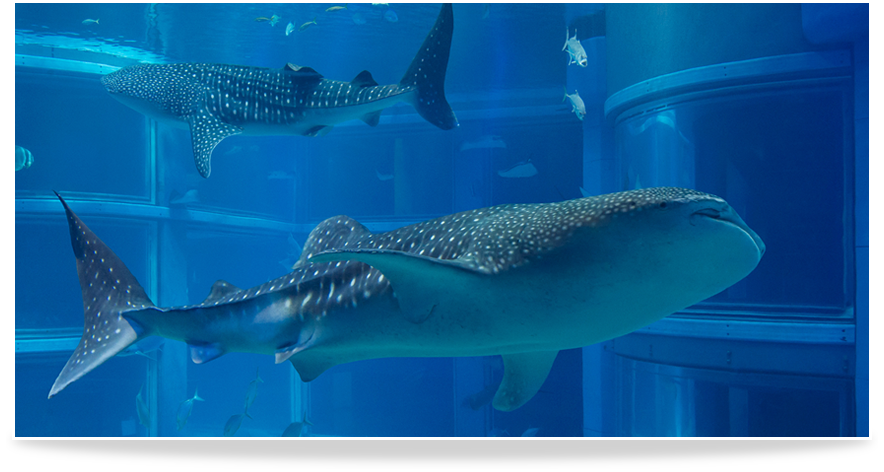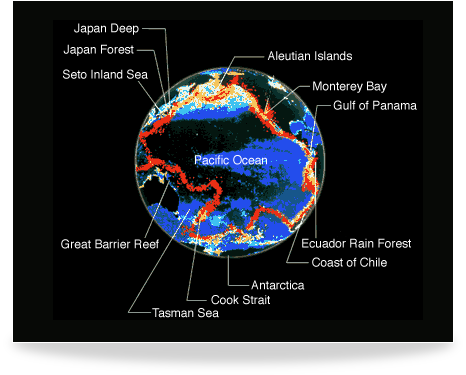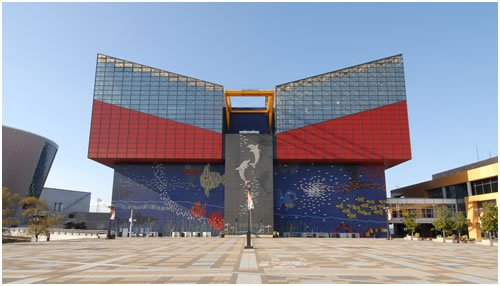Theme and Concept of the KAIYUKAN
Our planet and all living things on it are closely integrated with each other,
forming a single organism.

The principal theme for establishment of the Osaka Aquarium KAIYUKAN was based on the Gaia hypothesis proposed by Dr. James Lovelock.* The Gaia hypothesis is an ecological theory that the Earth with its many active volcanoes and all of its living creatures closely interact with each other to form, and function as, a single organism. Moreover, considering that there is considerable geographical overlap in the Pacific Ocean region between the Pacific Rim volcanic belt with frequent volcanic eruptions and an area characterized by rich biodiversity, the KAIYUKAN embodies the concepts of “the Ring of Fire” and “the Ring of Life” into all its exhibits.

The aquarium tour starts at the “Aqua Gate” zone. Proceeding through a tunnel-shaped tank, visitors can experience feeling as if they were underwater among a wide variety of fishes. Then, the tour route leads to various different zones such as “Japan Forest” filled with bright sunlight and “Pacific Ocean” where a whale shark, the largest fish in the world, is exhibited in a tank containing 5,400 tons of water. Walking the full length of the tour route, passing twice around the various levels of the aquarium, visitors can feel and experience both ground and marine environments of the Pacific Rim region.
The KAIYUKAN exhibits not only fish; a wide variety of marine life including amphibians, reptiles, birds, and mammals as well as marine invertebrates and plants can also be observed in the aquarium. By exhibiting some 30,000 marine creatures representing 620 species, the KAIYUKAN recreates the beautiful and diverse natural environments found around the Pacific Rim region.
Osaka Aquarium KAIYUKAN strives to make continued efforts to convey the attractiveness of marine creatures, the preciousness of life and the importance of environmental conservation to as many visitors as possible. As part of wildlife preservation efforts, the aquarium will also continue focusing on research and environmental protection activities in cooperation with all those concerned with oceans and their living creatures.
James Lovelock
A British scientist who advocated the Gaia hypothesis. He developed the hypothesis during his participation as a research collaborator in a space exploration project, particularly a project aiming to detect life on Mars, run by the National Aeronautics and Space Administration (NASA). Immediately after publication of his proposal, the Gaia hypothesis captured attention worldwide. He has served as a fellow of the UK National Academy of Science and president of the UK Marine Biological Association.
Ring of Fire (the Pacific Rim volcanic belt)
The red dotted ring depicted in this image represents the Pacific Rim volcanic belt, where earthquakes and volcanic eruptions frequently occur. Because the belt surrounds the entire Pacific Ocean, it is also called the “Ring of Fire.”
Ring of Life
The green dots depicted in this image represent the distribution of biodiversity in the Pacific Ocean. Bright green indicates a high density of life forms and deep green means a lower density. Because the coverage of both bright and deep green dots overlap the “Ring of Fire,” this is known as the “Ring of Life.”
